International Journal of Civil and Structural Engineering Research ISSN 2348-7607 (Online) Vol. 8, Issue 1, pp: (30-39), Month: April 2020 - September 2020, Available at: www.researchpublish.com
Property Characterization of Plaster Mortar Utilizing Sawdust and Rice HullAsh
Vanessa Mae M. Angue1, Charmaine Ericka M. Dela Cruz2, Faye Angel Maeh P. Kahano3 , Jenifer A. Magsino4 , Engr.
Siva Das P. Abaya5
Department of Civil Engineering, College of Engineering, Computer Studies and Architecture Lyceum of the Philippines University – Cavite, Governor’s Drive, General Trias, Cavite, Philippines 4107
Abstract: The production of cement and extraction of sand has led to long‒term damages to the environment. To alleviate these damages, ways on minimizing usage of cement and sand should be done. For this reason, the purpose of this research is to investigate the effect of reducing the cement and sand content of plaster mortar and partially replaced the two with rice hull ash and sawdust. To assess and evaluate the quality of plaster mortar utilizing sawdust and rice hull ash, a series of test was conducted such as: flow table test, length change test, compressive strength test and a visual inspection of the applied plaster. The method chosen for this study is the experimental method and four (4) mix design ratios were proposed with a 1:4 cement-sand ratio. The results show that the best mix identified within the limitations on this study, is the plaster mortar having a ten percent partial replacement of cement with rice hull ash (by weight) only. This mix design has achieved good workability, has a lower shrinkage percentage and higher compressive strength of 7.13 MPa, in comparison with the control sample. It has a smooth plaster finish and similar color with the ordinary, cement-based plaster. The use of rice hull ash as partial replacement to cement is recommended; not only it minimizes the usage of cement, but also it improves the overall quality of plaster mortar.
Keywords: Common byproducts, Plaster Mortar, Property Characterization, Rice Hull Ash, and Sawdust.
I. INTRODUCTION
Cement and Sand, being two of the most used construction materials has become a household material in every construction project. The surge in the need of its consumption has resulted in the massive production of it. Meanwhile, the annual extraction of sand is around 40 billion tons, with construction industries as its number one consumer. One way to alleviate this problem is to utilize these solid wastes in construction materials. For the partial replacement of Rice Hull Ash with cement, one study entitled ―Influence of Rice Husk Ash as Supplementary Material in Cement Paste and Concrete‖ showed that that RHA can be appropriately used as a supplementary material in cement paste and concrete preparation, subject to the following considerations; (1) The usage of an optimum mixture of 10% RHA are considered moderate strength concrete or structural concrete and can be used for structural work, (2) RHA prolongs or lengthens the setting time of the concrete thus reduces cracks in the concrete and prevents the abrupt evaporation of heat in massive concrete structures (M. Calica, 2008). Therefore, in this study, the researchers had determined and described the properties of plaster mortar that utilizes sawdust and rice hull ash as partial material replacement in its mixture. The scope and limitations of this study includes the following; (a) cement-sand ratio of 1:4 is used for the mix design of this study; (b) ten percent of the weight of cement per mixing batch will be replaced by rice hull ash; (c) sand will be partially replaced by sawdust in five (5), ten (10) and fifteen (15) percent of the sand’s weight per mixing batch; (d) the application of mortar as plaster on a concrete hollow block will be on two coats. First coat is 12 mm and the second coat is 8 mm; (e) physical and mechanical properties of the plaster mortar include its density, compressive strength, shrinkage strain, as well as the color and texture when applied as plaster; (f) the dimension of the cube samples is 2 in. x 2 in. x 2 in and the dimension of the prism samples were 1 in. x 1 in. x 11.25 in; (g) flow table test is done prior to casting of cube
International Journal of Civil and Structural Engineering Research ISSN 2348-7607 (Online) Vol. 8, Issue 1, pp: (30-39), Month: April 2020 - September 2020, Available at: www.researchpublish.com
and prism specimens; (h) flow table test, mixing of mortar samples, casting of mortar into cube molds and application of mortar as plaster on concrete hollow blocks is done by the researchers following the ASTM standard procedure; (i) only a visual inspection is performed to describe the plaster samples.
II. LITERATURE REVIEW
A. Foreign Studies
Song et. al. (2015) investigated the effect on the compressive and flexural strength of using Rice hull ash (RHA) as a partial replacement for cement. Thermal treatment for the rice hull was done in a muffle furnace and cement mortar samples were made with varying proportions of RHA (0%, 5%, 10%, 20%) and varying temperatures for each RHA percentage. The samples were casted in a 40 x 40 x160 mm and let cured for 24 hours. The specimens were tested at the third, seventh and twenty-eighth day. Test results yielded that 10% of RHA replacement (by weight) has the best cement strength enhancement and at twenty percent RHA replacement, the compressive strength of concrete was significantly reduced. It was also observed that at 10% RHA replacement, the RHA produced by the controlled thermal treatment was high in pozzolanic activity, meaning – RHA contained the presence of high amorphous silica and high specific area.
Rasoul (2018) determined the optimal temperature and exposure time relationship to produce highly active RHA using electric muffle furnace. Results show that RHA appeared to be in totally amorphous form at the incineration temperature of 425℃ for 60 to 90 minutes.
Tilak et. al. (2018) examined the potential use of wood sawdust waste as a fine aggregate for concrete. Varying proportions (0%, 10%, 20%, 50%, 100%) of sand was replaced by sawdust and the average compressive strength of the specimens for each proportion was measured at 7, 14, 21, and 28 days. Results showed that at the 28th day, the ten percent replacement of sand with sawdust increased its compressive strength but the twenty percent replacement of sand with sawdust significantly reduced the compressive strength of the concrete specimen.
Adebakin et.al. (2012) also got ten percent replacement of sand with sawdust as the optimum mixture for the compression strength of concrete specimen that were made. However, this optimum mixture is insignificant in terms of improving the properties of concrete because the values showed that this optimum mixture did not surpass the compression strength of the concrete with 100 percent sand as fine aggregate.
Mariyana et. al. (2016) studied the physical and mechanical properties of concrete containing sawdust with specimens having different cement to sawdust ratios by volume. It was observed that, with the increasing the amount of sawdust, workability and density of concrete decreases. Strength of sawdust increase for the duration of the curing period and the modulus of elasticity decreased with the increasing amount of sawdust. It has been concluded by the study that sawdust concrete can be used suitably as a building material in construction.
B. Local Studies
Calica M., (San Fernando, La Union) discovered the potential of rice husk ash in the Philippines as a supplementary material in cement paste and concrete. The presence of rice husk ash in cement paste influences the normal consistency of the cement paste mixture and its setting time. Rice husk ash causes the cement paste to absorb large amount of water. Initial setting time is 108 minutes for cement with rice husk ash, and 212 minutes for cement without it. Hardened concretes with up to 10 percent of rice husk as partial replacement are considered moderate strength concrete or structural concrete and can be used for structural work while concrete with 20 percent rice husk ash is considered low-strength concrete and can be utilized for non-structural concrete works.
Amid the rising cost of construction materials, the Department of Science and Technology (DOST) is promoting the use of rice hull ash as ingredient for making hollow blocks. The DOST’s Forest Products Research and Development Institute (FPRDI) recently developed rice hull ash cement (RHAC) hollow block a combination of refined rice hull ash, cement and sand. (Ong G. and Flores H.)
Aguilar et. al. (2013) investigated the possibility of using sawdust as a fine aggregate in concrete mixture with both mixtures categorized as Class A. The study revealed that the concrete mixture using sawdust is comparable to the compressive strength of concrete mixture using sand as fine aggregate therefore, sawdust can be considered as an alternative for sand as fine aggregate.
International Journal of Civil and Structural Engineering Research ISSN 2348-7607 (Online) Vol. 8, Issue 1, pp: (30-39), Month: April 2020 - September 2020, Available at: www.researchpublish.com
III. METHODOLOGY
A. Research Design
In setting up the study, experimental method was used to investigate the effect of partially replacing sand and cement with sawdust and rice hull ash in a plaster mortar mixture. For this purpose, flow table test, compressive strength test and length-change test were carried in accordance to ASTM Standard of Tests. Materials and instruments pertinent to the study were also selected and gathered in line with the ASTM standards. These materials were gathered locally and comprises of the following:
Portland Cement
Cement used is the ordinary Portland cement conforming to ASTM C150. Portland Cement Type I was used for the plaster mix as it is classified for general purposes of construction.
Rice Hull Ash
Rice hulls are procured initially. Thermal treatment of rice hull will turn it into ashes. This is done by using a muffle furnace set at 425 degrees Celsius for 90 minutes, as per study of Rasoul (2018) to obtain an amorphous state of silica in the composition of rice hull ash. Rice hull ash will replace 10% of cement (by weight).
Fine aggregates
The fine aggregates in this study is the commercially available sand used in general construction and sawdust that is procured locally from the Cavite area and is sieved first by the no. 8 sieve before mixing into the plaster mix proportion. These fine aggregates were subjected to fine aggregate quality testing prior to mixing of plaster mortar. The result of the test is in accordance with the ASTM standard C270 – 00 for it to be used in the plaster mixture. The tests conducted determined its grading, soundness, organic impurities, clay lumps and friable particles.
Concrete Hollow Block
Procured from a local hardware with the dimension of 10cm (width) x 20 cm (height) x 40cm (length).
B. Mix Design
In the study, the proponents produced plaster mortar specimens with a 1:4 cement-sand ratio. The designation of each mortar specimen is as follows:
TABLE
Symbol
I:
DESIGNATION OF MORTAR SPECIMENS
C. Procedure
The materials were prepared and mixed in conformity with ASTM Standards. Rice hull was burned in a muffle furnace and is then mixed with cement by ten percent of its weight per mixing batch. Fine aggregates, sand and sawdust, were prepared according to the ratios proposed in this study and was sent to the Imus Testing Center for quality testing. Upon a passed remark from the fine aggregate result, mixing of the mortar samples were conducted following the ASTM standard procedure for mixing cement mortar. (ASTM C305 - 06). Flow Table Test was done immediately after mixing to measure the degree of consistency and workability of the plaster mortar mixture. This is in accordance to ASTM C 1437 –07. Next, a portion of the mortar produced under each batch specimen is casted in a 2‖x2‖ mold and tested for its compressive strength for day 1, 3, 7 and 28 as in accordance with ASTM C109/C109M-12 ―Standard Test Method for Compressive Strength of Hydraulic Cement Mortars Using 2 inch or [50mm] Cube Specimens‖. Each batch of specimen consists of 3 samples for each day that it will be tested. The average compressive strength of these three samples will be the value of the compressive strength of each specimen on that day. For the length-change test, each batch specimen is
International Journal of Civil and Structural Engineering Research ISSN 2348-7607 (Online) Vol. 8, Issue 1, pp: (30-39), Month: April 2020 - September 2020, Available at: www.researchpublish.com
molded in a prism of 1-in. (25-mm) square cross-section and approximately 11 1/4 in. (285 mm) in length. Four samples are prepared for each test specimen. All specimens were cast in the field and subjected to curing at for the first 24 hours. Length-change measurements for each specimen were then carried out at the first, third, seventh, and fourteenth day after recording its second initial shrinkage (zero shrinkage strain) reading. The remaining plaster mortar mix is applied to concrete hollow block in two coats. First coat is 12 mm and second coat is 8 mm.
IV. RESULTS AND DISCUSSION
A. Fine Aggregate Quality Testing
Tests were conducted to determine the grading, soundness, organic impurities, and clay lumps and friable particles of the fine aggregates used in each type of mix design. ASTM C897 states the standard specification of characteristics most cement-based plasters shall possess. The results of the characteristic of the fine aggregate used in this study will be compared and evaluated with the standard specification of ASTM for plasters.
Grading.
Grading of aggregates were determined through sieve analysis. The ASTM criteria used as a comparison with the gradation of the aggregates that was used in this plaster study, is for natural sand. Results yielded that the grading of the aggregates used in the study falls between the ASTM criteria range for natural sand, thereby passing the grading test.
Clay Lumps and Friable Particles.
Test results yield that none of the batch samples exceeded the ten percent ASTM Standard limit for the allowable clay lumps and friable particles present in fine aggregate.
TABLE II: PERCENTAGE CONTENT OF CLAY LUMPS AND FRIABLE PARTICLES OF THE BATCH SAMPLES
Batch Sample
Soundness.
ASTM STANDARD FOR Plaster Remarks Sieve Size3/8 to no. 4 Sieve Size no. 4 to no.8
Percent of Clay Lumps and Friable Particles
Sand 0.25% 0.55%
Passed
S5 0.30% 0.80% Passed
Less than 10%
S10 0.75% 0.95% Passed
S15 0.55% 0.95% Passed
The chemical used for the soundness test is Sodium Sulfate. All the batch samples showed a total loss of less than twenty percent which implies that all the batch samples aggregate passed the soundness test.
Organic Impurities.
As per the results from the testing center, the aggregates for each batch are free of organic impurities, therefore the aggregates passed the organic impurities test and is permitted to be used as aggregates for plaster.
B. Flow Table Test
A flow table test was conducted prior to casting of specimens into molds and applying them on concrete hollow blocks. The in situ water cement ratio of each specimen is determined in the process of mixing, but the initial water cement ratio is 0.5 and is gradually increased until the mortar shows good workable consistency. The appearances of mortar on flow test remains similar regardless of the mix design content it was intended for. It was observed that batch sample S0 and S5 showed a similar appearance with the conventional sample although the presence of rice hull ash and sawdust increased the water demand for the mortar. Batch sample S10 and S15, showed mild to severe segregation of cement paste to the aggregates with its very high water demand.
Fig. 1. Flow test of batch sample CS, S0 and S5 respectively (left to right)

Fig. 2. Flow test of batch samples S10 and S15 respectively (left to right)
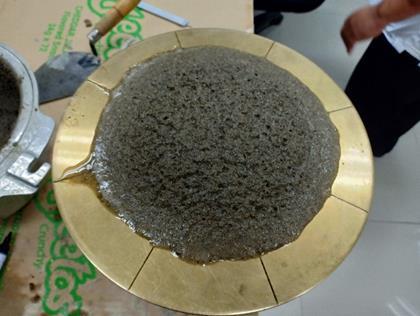
Fig. 3. Compressive strength development of the five batch samples
Based on figure 3, batch sample S0 showed the highest compressive strength among the batch samples at 7.13 MPa on day 28. It surpassed the compressive strength value of the control sample that is at 5.93 MPa. The compressive strength values of S5, S10 and S15 are very much closely related to one another and falls behind so much from batch sample CS and S0 having their values at 1.63, 0.73 and 0.77 MPa respectively at day 28. It could be implied that partially replacing cement with rice hull ash can improve compressive strength however, the presence of sawdust in the mixture can degrade the strength performance of the mortar. ASTM C270-10 or the Standard Specification for Mortar for Unit Masonry has a property specification requirement for mortars such as the one in this study. For plasters, it falls under the mortar category of masonry cement, type N. Masonry type N is for general purpose mortar mix and can be used for above grade interior and exterior installations. This type requires a minimum compressive strength of 750 Psi (5.2 MPa). Comparing this from the batch samples at the 28th day, only CS and S0 have passed this requirement.
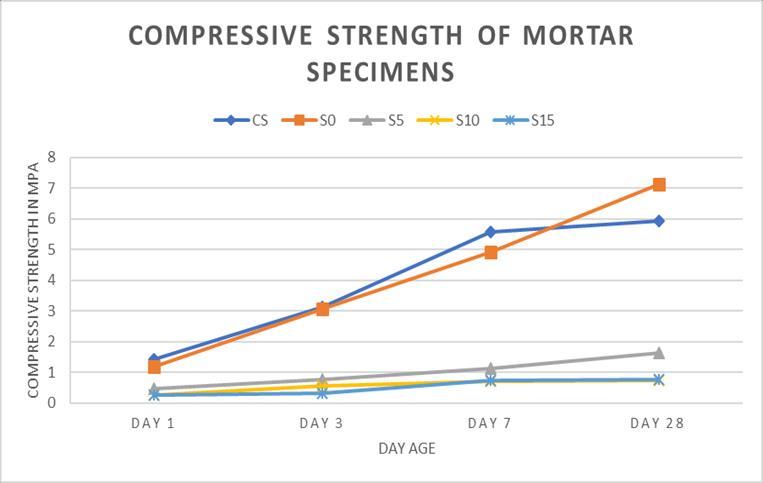
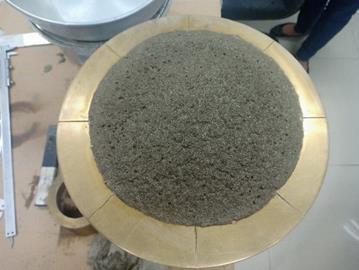
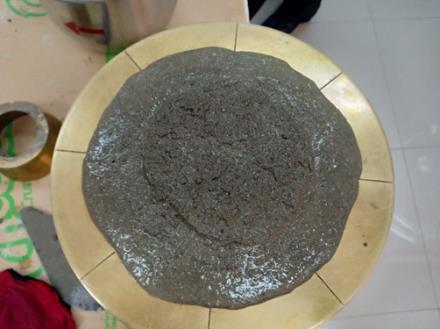

International Journal of Civil and Structural Engineering Research ISSN 2348-7607 (Online) Vol. 8, Issue 1, pp: (30-39), Month: April 2020 - September 2020, Available at: www.researchpublish.com
D. Density
Fig. 4. Density of the five batch samples at day 28
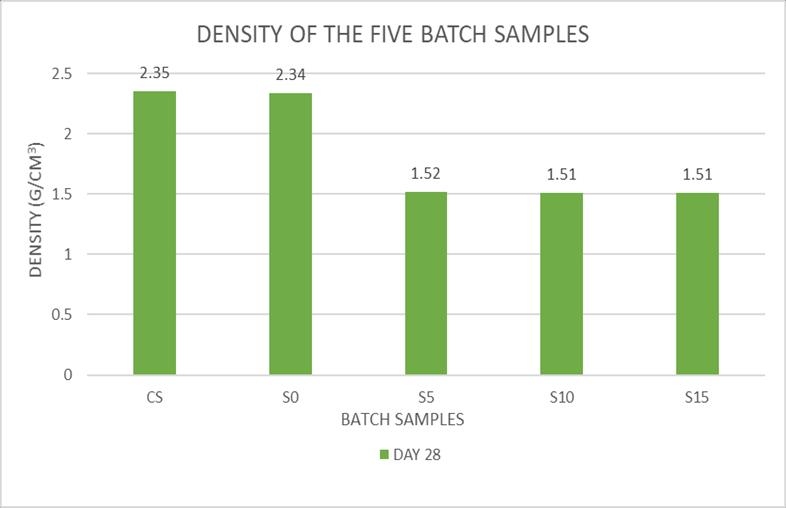
As shown in Figure 4, batch sample S15 and S10 has the least density value of 1.51g/m3. It can be inferred that as sawdust content increases in the mortar mix, the more porous the outcome mix becomes. This may be attributed to the shape of the sawdust particles and air entrapped inside the mortar (Abubakar M. et al., 2013) Hence, the bubbles that appeared on the table after it had been dropped during the flow table test, is entrapped air. Due to this, it is evident that this is the reason for the low compressive strength result of mortar mixes utilizing sawdust.
E. Length Change of Plaster Mortar
Fig. 5. Length change test result of the five batch samples from day one to fourteen
The standard test method for hardened hydraulic cement mortar and concrete (ASTM C 157) was conducted on all 5 batch samples to determine the length change as it is exposed to open air. Batch sample S5 exhibited the highest drying shrinkage percentage of 5.210% at the fourteenth day, and has the maximum values throughout the whole fourteenth day period as compared to the two samples. This is due to its high water cement ratio (Bury M., et. al.,2017). Batch sample CS obtained a 1.985% shrinkage value and S0 has a shrinkage value of 1.365%. Batch sample S0 has the lowest drying shrinkage throughout the whole fourteenth day period. This is attributed to its low cement content. This result concurs to the study of other researchers such as Shittu, A. and Fapohunda C., 2017 and Rasoul B., 2018. In their study, the increasing addition of RHA in partially replacing cement leads to the decrease in the drying shrinkage and that it is a strategic way to reduce the drying shrinkage of mortar by using RHA. For batch samples S10 and S15, both showed incompetence for the length change test because during its demolding process the samples broke easily even with careful demolding. Also, these two samples were perceived to have very low strength as they failed to hold the screw placed on both sides of the sample.
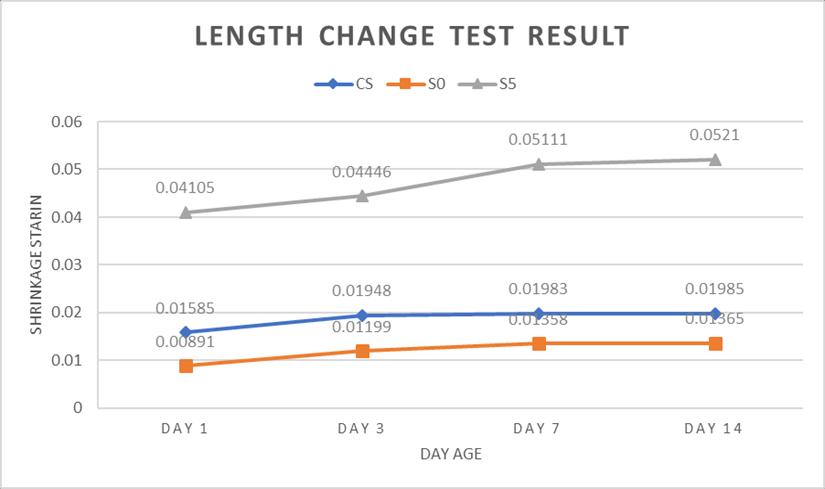
International Journal of Civil and Structural Engineering Research ISSN 2348-7607 (Online) Vol. 8, Issue 1, pp: (30-39), Month: April 2020 - September 2020, Available at: www.researchpublish.com
F. Application of Plaster on Concrete Hollow Block
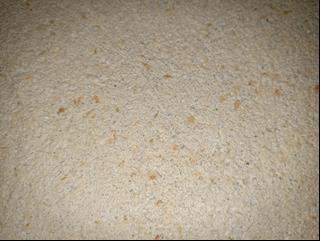
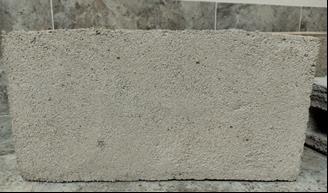
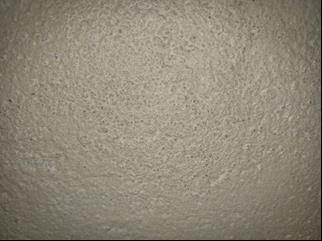
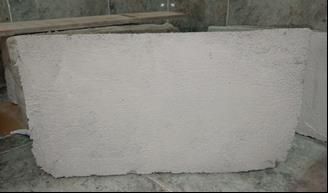
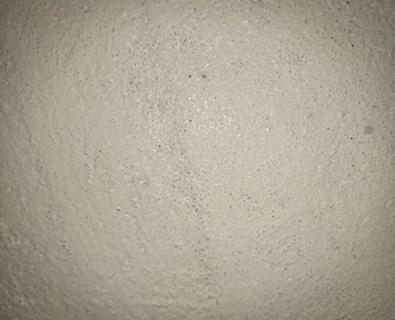
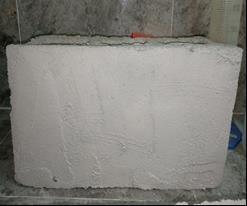
Through visual inspection the physical characteristics of plaster on its 28th day, such as its color and texture were observed. For the control sample, it is the typical cement based plaster having a grey to white color and a smooth glossy finish. Plaster sample S0 also had a smooth glossy finish and identical color to the control sample. Plaster sample S5 has a white to grey color with distinct brown spots. This brown spots are the sawdust particles that are well encapsulated by the binder. This plaster sample also had a smooth glossy finish. Plaster sample S10 has a grey and brown color that can be distinguished. It has a rough texture and the sawdust particles falls off from the concrete hollow block especially when the plaster is touched or rubbed by hand. Plaster sample S15 is identical to S10 regarding its color and texture however the flaking of sawdust particles is more apparent.
Fig. 6. Visual appearance of batch sample CS
Fig. 7. Visual appearance of batch sample S0
Fig 8. Visual appearance of batch sample S5
Fig. 9. Visual appearance of batch sample S10
Fig. 10 Visual appearance of batch sample S15
G. Optimum Mix
To determine the optimum plaster mortar mixture, it must exhibit good properties on its workability and strength development. Table III, summarizes the tests done on the fresh and hardened state of the batch samples mortar mix. The check sign signifies it has performed satisfactorily on the test performed and the cross sign signifies that the sample had failed or has performed inadequately on the test done. The mix which showed good performance on almost all of the test shall be concluded as the optimum mix.


TABLE III: SUMMARY OF THE TEST PERFORMANCE OF THE BATCH SAMPLES Test Batch sample
From the table, it can be inferred that batch sample S0 is the optimum mix because it has demonstrated good performance on all the tests performed. Batch sample S0 has good workability which exhibited good results during flow test. It did not indicate signs of segregation and can be easily mixed and placed as plaster on the concrete hollow block. In the drying shrinkage test, the lower the value of the shrinkage percentage, the more the mix is desirable for use. Batch sample S0 showed a lower shrinkage value than CS all throughout the 14th day period. For the compressive strength test, batch sample S0 passed the ASTM minimum requirement value of compressive strength, and had greatly surpassed the compressive strength value of CS. On the visual inspection, batch sample S0 is extremely alike in appearance with the control sample and did not showed any signs of sloughing or delaminating from the concrete hollow block, which indicates good cohesion and adhesion property.
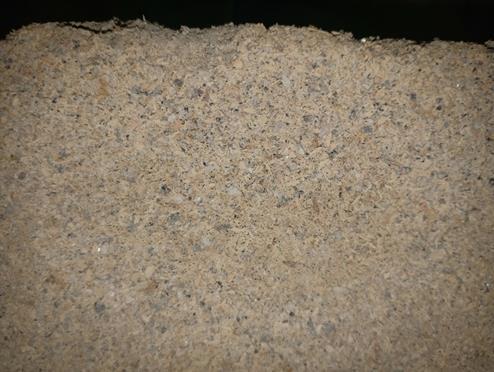
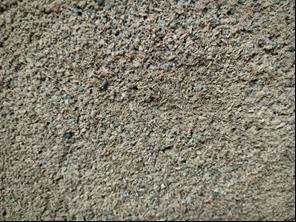
International Journal of Civil and Structural Engineering Research ISSN 2348-7607 (Online) Vol. 8, Issue 1, pp: (30-39), Month: April 2020 - September 2020, Available at: www.researchpublish.com
V. CONCLUSION AND RECOMMENDATIONS
A. Conclusion
S0 or the 10% partial replacement of cement with rice hull ash is the optimum plaster mortar mixture for this study. This mix design yielded a better compressive strength development, and a low drying shrinkage among the samples. Despite an increase in the water cement ratio, its mortar maintained good workability. Partially replacing sand with sawdust, made the density of the hardened mortar to be lighter than the conventional cement mortar mix implying that as sawdust content increases in the mortar mix, the more porous the outcome mix becomes. It is evident that this is the reason for the low compressive strength result of mortar mixes utilizing sawdust. The researchers conclude that the use of sawdust in partial replacement of sand along with the partial replacement of cement with rice hull ash for plaster use is feasible, however further studies to lower the water requirement and improve the strength development is recommended.
B. Recommendations
For the further investigation on the effect of partially replacing cement with rice hull ash and sand with sawdust for plastering works, the following recommendations were made;
1. Chemical analysis on Rice Hull Ash to see if the RHA contains highly reactive amorphous silica which what will make it a better substitute for pozzolanic cement.
2. Additional mix ratio where only sand will be replaced by 5% sawdust and the cement will be as is (100% Cement + 95% Sand + 5% Sawdust). This is to see if the RHA affects the workability of the mixture in regard with the segregation of the cement paste to the aggregates.
3. To push for the idea of partially replacing sand with other waste material to promote sustainable engineering without compromising the ideal plaster properties
4. Conduct bond strength test to test the adhesion of the plaster to masonry wall.
5. Perform water absorption test to see if the plaster will be suitable for exterior wall plastering which is constantly exposed to rainwater.
REFERENCES
[1] Adebakin, I., Adeyemi, A., Adu, J., Ajayi, F., Lawal, A. & Ogunrinola O. (2012). ―Uses of sawdust as admixture in production of lowcost and light-weight hollow sandcrete blocks‖. American Journal of Scientific and Industrial Research. 3(6): 458-463. doi:10.5251/ajsir.2012.3.6.458.463
[2] Bie, R., Song, X., Liu, Q., Ji, X., & Chen, P. (2015). ―Studies on effects of burning conditions and rice husk ash (RHA) blending amount on the mechanical behavior of cement‖. Cement and Concrete Composites. 55.162–168.. doi:10.1016/j.cemconcomp.2014.09.008
[3] Elakkiah C. (2018). Rice Husk Ash (RHA)‒The Future of Concrete. Sustainable Construction and Building Materials: Select Proceedings of ICSCBM 2018, 25, 439-448. doi:10.1007/978-981-13-3317-0_39
[4] Fapohunda C., Bolatito A. & Shittu A. (2017). Structure and Properties of Mortar and Concrete with Rice Husk Ash as Partial Replacement of Ordinary Portland cement – A Review. International Journal of Sustainable Built Environment, 6. doi: 10.1016/j.ijsbe.2017.07.004
[5] Jennings H. and Thomas J. (2018). Portland Cement. Retrieved from http://iti.northwestern.edu/cement/ monograph/Monograph3_8.html
[6] Kumar S., Sangwan P., Dhankhar R. Mor V., & Bidra S. (2013). Utilization of Rice Husk and Their Ash, Research Journal of Chemical and Environmental Sciences, 1. (5),126-129.
[7] Michelle Jones. (2017). Top 4 Reasons why Rice Husk Ash and Hull Ash is more than just a waste product. Retrieved from https://medium.com/@michelllejones/top-4-reasons-why-rice-husk-ash-and-hull-ash-is-more-than-awaste-product-20ef7be7ad35
International Journal of Civil and Structural Engineering Research ISSN 2348-7607 (Online) Vol. 8, Issue 1, pp: (30-39), Month: April 2020 - September 2020, Available at: www.researchpublish.com
[8] Nidoy M. (November 2016). Rice husks as sustainable energy resource. Retrieved from: https://www.philrice gov.ph/rice-husks-sustainable-energy-resource/
[9] Rice Husk. (n.d.) Retrieved from http://www.knowledgebank.irri.org/step-by-step-production/postharvest/rice-byproducts/rice-husk
[10] Singh B., Cachim P. & Siddique R., (2018). Waste and Supplementary Cementitious Materials in Concrete. Retrieved from https://www.sciencedirect.com/topics/engineering/rice-husk-ash
[11] Tilak, L., Kumar S., Singh, M., & Niranjan. (2018). Use of Sawdust as Fine Agreggate in Concrete Mixture. International Research Journal of Engineering and Technology.5(9). 1249-1253.
